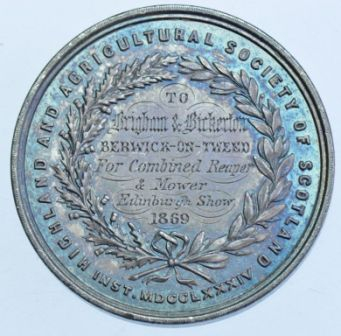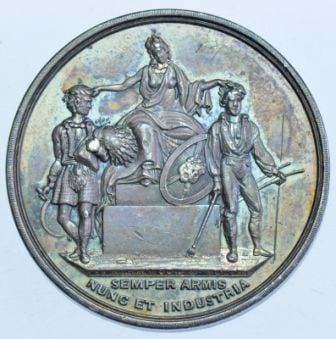Options
How to capture the Color's / Toned coins in a Picture?
 Gluggo
Posts: 3,566 ✭✭✭✭✭
Gluggo
Posts: 3,566 ✭✭✭✭✭
I am looking for help on ways to set up the lighting or camera on a toned coin. I recently bought a coin that has blue in its tone. Yet when I try to snap a shot of this color its very difficult to capture that. Here is a stock color that the seller had and you can see the blue tone. Yet when I snapped my pictures on my camera it was hard to get that blue tone. Do I need a blueish light bulb?
Any idea's would be appreciated. TYIA


0
Comments
Capturing that "deep" color on toned coins requires the lighting to be at a very high angle. Many folks will put the light at as high an angle as possible, then tilt the coin (or medal in this case) so that the light reflects directly off the coin to the camera. This similates "axial" lighting and is the way most folks view coins in-hand. Shining light off the coin at an angle does not produce the correct interference patterns from the oxides/sulfides on the surface of the coin, so does not show color correctly vs the "in-hand" look.
http://macrocoins.com
Thank you rmpsrpms gives me something to play with now!
Here is my latest attempt to capture the blue in the coin using the high axiel technique. I still have a long way to go. I am seeing some of the blue captured.
Not too bad.
One thing you can do to make sure the lighting is even and at correct angle is to put a mirror where the coin goes. The light should cover the whole mirror and shine evenly to the camera. IOW when you take the pic, you'll just see a uniform bright light. Put the coin on the mirror (or in place of it) and this will then be very "axial" in nature.
Another thing to do is make sure your aperture is fairly small. this ensures the light hitting the coin is coming in a narrow range of angles and improves color rendering. f/11 or even f/16 for large medals is perfectly fine for this.
http://macrocoins.com
Please tell me more. How do you correctly show in hand look of interference patterns ?
Bottom line with coin photography is when you want to achieve the "in-hand look", you need to light the coin the same way you view it in-hand. The "deep color" look is usually with an overhead light shining directly onto the coin, so that's what you must reproduce when you are trying to get the same look in your photo.
http://macrocoins.com
@rmpsrpms
Thank you for that information.
Paint.net is often helpful. With paint.net you can tweak until it ...MOSTLY... looks like the real thing.
you might try a diffuser over the light source to PREVENT directional lighting. It potentially changes the depth of the image but might maintain the color.
Also, be careful about the background. Your camera is likely setting the white balance based on the image it sees. Changing a background from white to blue to black can really change the apparent color of the coin.
Thank you to all the posters to this thread. Valuable tips that benefit all coin photographers.
take it out into the sunlight and take pictures at various angles to see what angle works best for light source